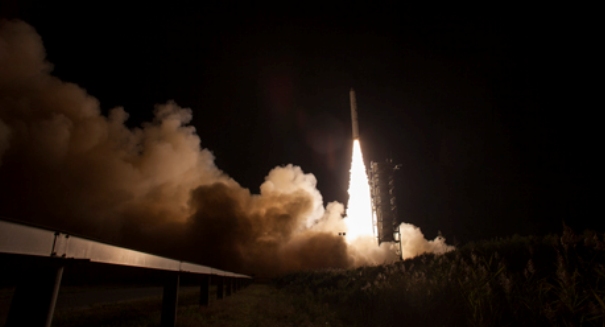
NASA captured thermal images of the SpaceX Falcon 9 rocket's descent, providing information that could help with future landings on Mars.
Thermal images of a SpaceX rocket on descent after a launch in September, recently captured by NASA, may help in providing important engineering information for future missions to Mars.
According to SpaceFlight Insider, SpaceX (officially known as Space Exploration Technologies) has been developing innovative technology such as descent capabilities on the first stage of their Falcon 9 v1.1 booster. NASA has taken an interest and tasked two aircraft to track the rocket’s descent into the Atlantic Ocean following a mission on Sept. 21.
“NASA’s interest in building our Mars entry, descent and landing capability and SpaceX’s interest and experimental operation of a reusable space transportation system enabled acquisition of these data at low cost, without standing up a dedicated flight project of its own,” said Charles Campbell, project manager of NASA’s Propulsive Descent Technologies (PDT) project, in a recent statement.
NASA reports that they were able to capture quality infrared and high-definition images and monitored changes in the smoke plume as the engines were turned on and off during the rocket’s return.
“Because the technologies required to land large payloads on Mars are significantly different than those used here on Earth, investment in these technologies is critical,” said Robert Braun, PDT principal investigator and professor at the Georgia Institute of Technology in Atlanta. “This is the first high-fidelity data set of a rocket system firing into its direction of travel while traveling at supersonic speeds in Mars-relevant conditions. Analysis of this unique data set will enable system engineers to extract important lessons for the application and infusion of supersonic retro-propulsion into future NASA missions.”
SpaceFlight Insider reports that no other company, aside from SpaceX, has carried out tests of this technology on an actual mission, performing actual supersonic retropropulsion.
“Through our partnership with SpaceX we’re gaining access to real-world test data about advanced rocket stage design and retro-propulsion,” said Michael Gazarik, NASA’s associate administrator for Space Technology at NASA Headquarters in Washington. “Through this partnership we’re saving the taxpayer millions of dollars we’d otherwise have to spend to develop and test rockets and flights in-house. This is another great example of American companies partnering with NASA to enable our future exploration goals.”
Leave a Reply